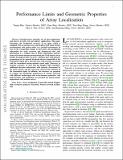Performance Limits and Geometric Properties of Array Localization
Author(s)
Han, Yanjun; Zhang, Xiao-Ping; Meng, Huadong; Shen, Yuan; Win, Moe Z
DownloadWin_Performance limits.pdf (901.9Kb)
OPEN_ACCESS_POLICY
Open Access Policy
Creative Commons Attribution-Noncommercial-Share Alike
Terms of use
Metadata
Show full item recordAbstract
Location-aware networks are of great importance and interest in both civil and military applications. This paper determines the localization accuracy of an agent, which is equipped with an antenna array and localizes itself using wireless measurements with anchor nodes, in a far-field environment. In view of the Cramér-Rao bound, we first derive the localization information for static scenarios and demonstrate that such information is a weighed sum of Fisher information matrices from each anchor-antenna measurement pair. Each matrix can be further decomposed into two parts: 1) a distance part with intensity proportional to the squared baseband effective bandwidth of the transmitted signal and 2) a direction part with intensity associated with the normalized anchor-antenna visual angle. Moreover, in dynamic scenarios, we show that the Doppler shift contributes additional direction information, with intensity determined by the agent velocity and the root mean squared time duration of the transmitted signal. In addition, two measures are proposed to evaluate the localization performance of wireless networks with different anchor-agent and array-antenna geometries, and both formulae and simulations are provided for typical anchor deployments and antenna arrays.
Date issued
2016-02Department
Massachusetts Institute of Technology. Department of Aeronautics and Astronautics; Massachusetts Institute of Technology. Laboratory for Information and Decision SystemsJournal
IEEE Transactions on Information Theory
Publisher
Institute of Electrical and Electronics Engineers (IEEE)
Citation
Han, Yanjun et al. “Performance Limits and Geometric Properties of Array Localization.” IEEE Transactions on Information Theory 62.2 (2016): 1054–1075.
Version: Author's final manuscript
ISSN
0018-9448
1557-9654